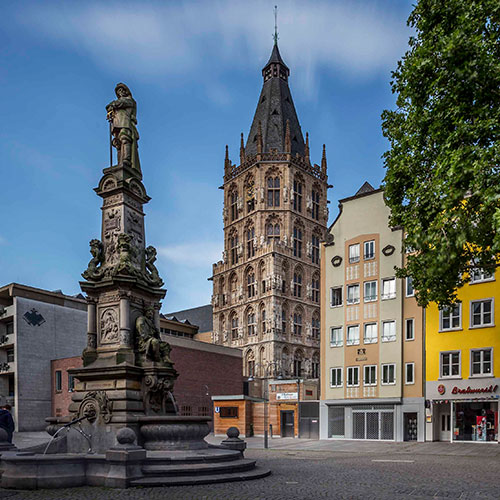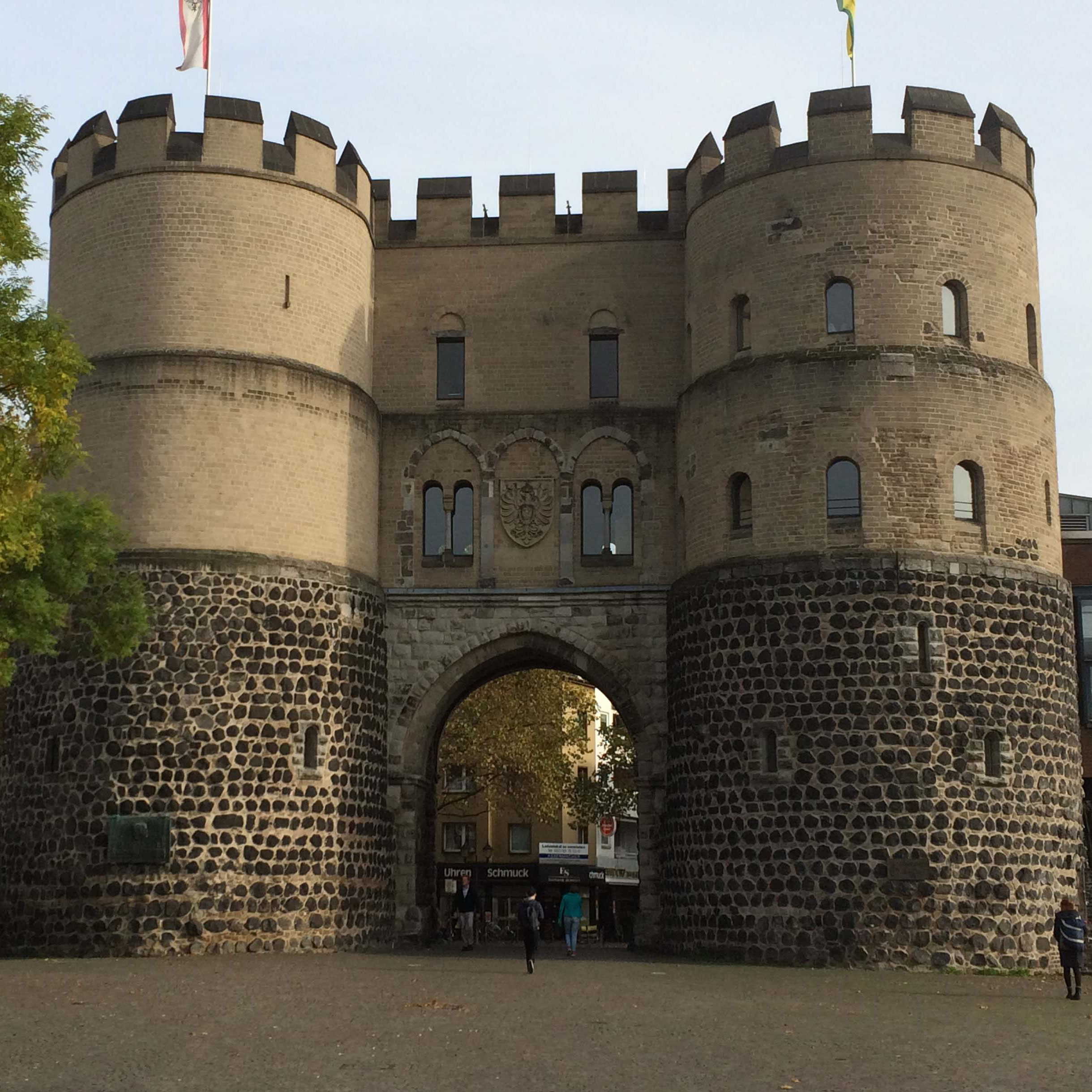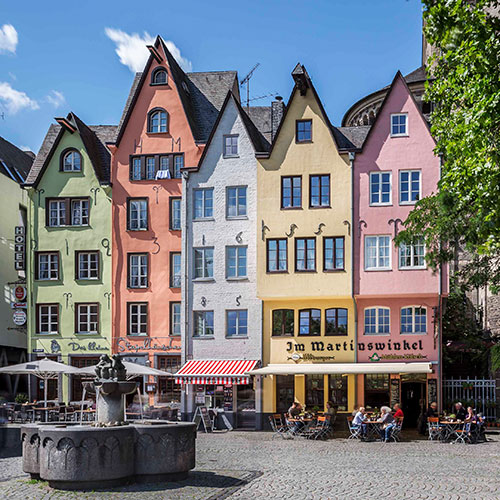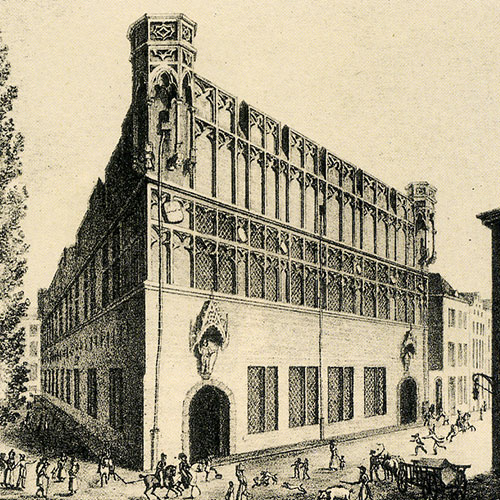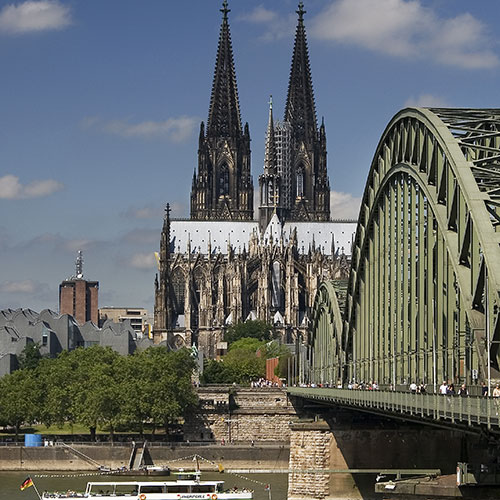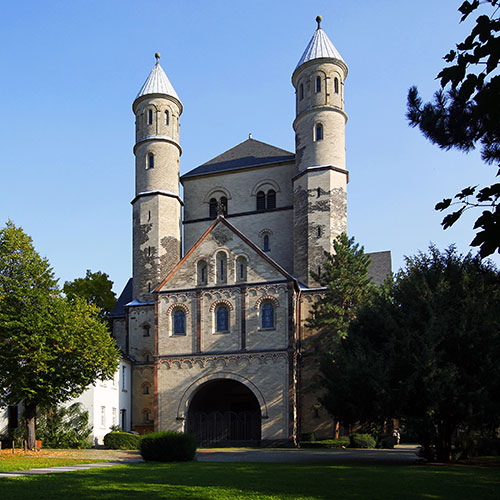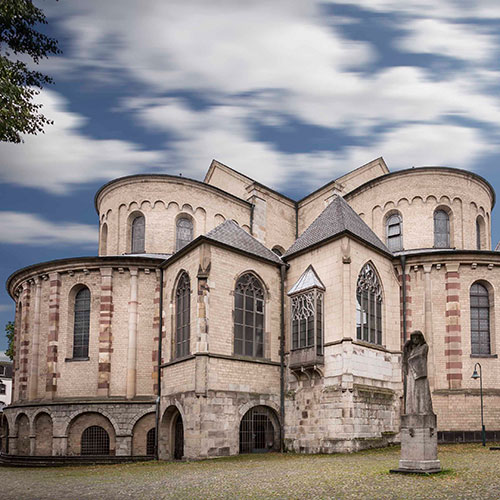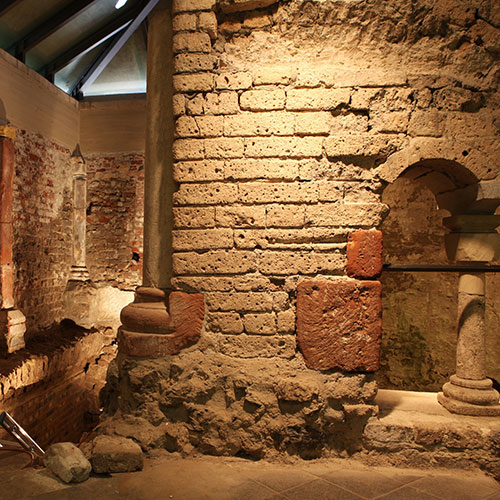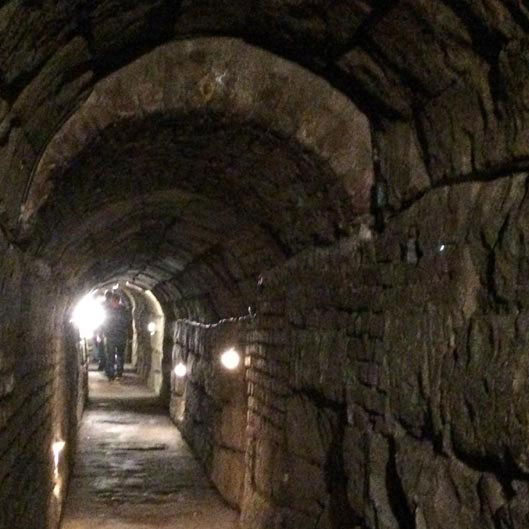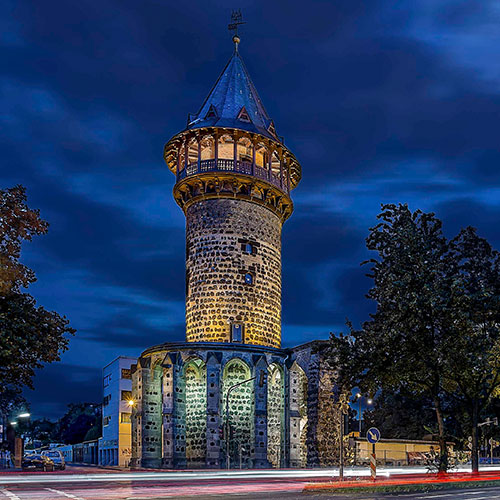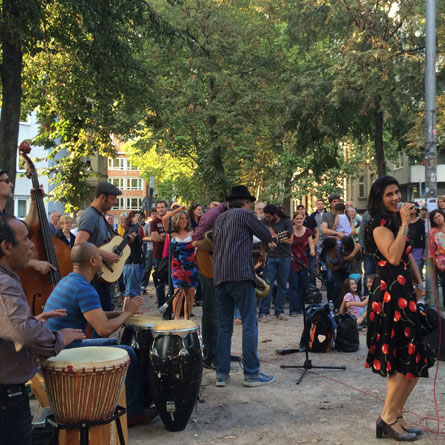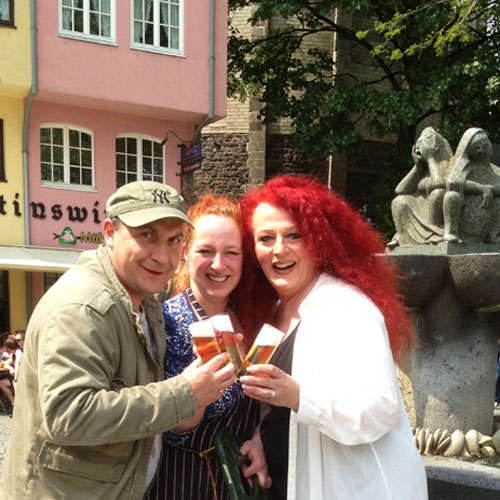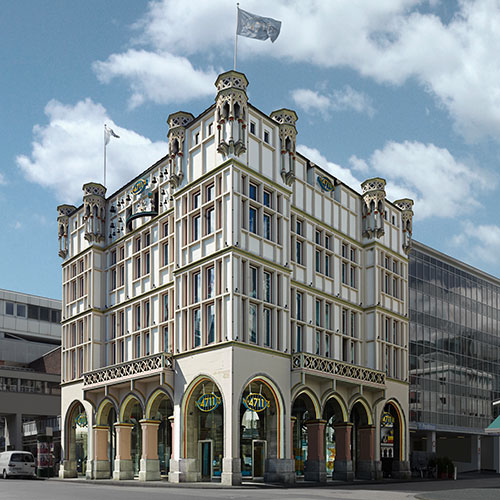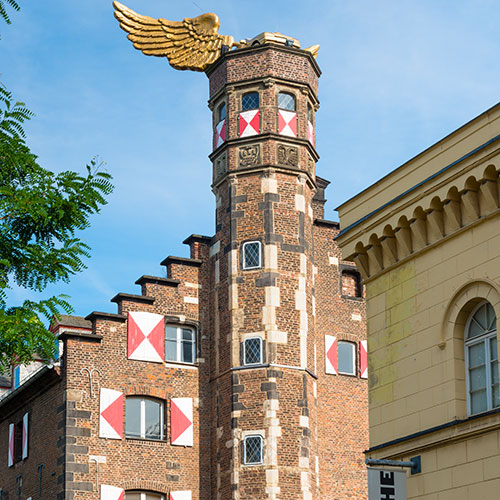The History of the City of Cologne
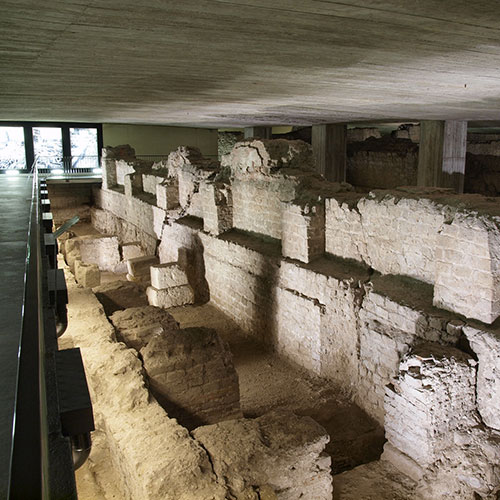
To summarize the history of a city is already a challenge for most cities. This is all the more true for the 2000 year history of the city of Cologne. For more detailed information, please refer to the encyclopedia Wikipedia. Photo : © Christina Kohnen
City tours with Tour-Agentur
In order to grasp the comprehensive economic and cultural history of the city of Cologne in its entirety and to understand the overarching interrelationships, a city tour with a certified city guide is recommended.
History of the City of Cologne :
Cologne’s 2000 years of history begin in 57 AD, when Julius Caesar, during the Gallic Wars, conquered the territories on the left bank of the River Rhine. The Rhine formed the border between the Roman Empire on the western bank and the Germanic area on the eastern bank. In 50 AD, Cologne received its city charter and the name “Colonia Claudia Ara Agrippinensium” (CCAA). In the late 1 st century, Cologne was made capital of the Roman province Lower Germania. In the mid-5 th century, it was conquered by the Franks.
From the 10 th to the 16 th century, Cologne developed into Germany’s largest and wealthiest city. A population of ca. 40 000 lived on an area of 4 square kilometres (ca. 2, 5 sq. mi.). It was said of Cologne that it had as many churches as there are days in a year, and the people of Cologne wanted to cap this by building what was meant to be the largest church in the world. In 1248, the foundation stone to the Cathedral was laid, but 300 years later, 1560, the construction works were discontinued and the building was abandoned only partially finished.
The colonization of America made travel routes move further towards the Atlantic Ocean and Cologne lost its economic power. In 1794, French troops occupied Cologne and modern times found their way to Cologne. The Vienna Congress allotted the Rhineland to Prussia. In the age of industrialization, Cologne developed into one of Germany’s leading economic centres. In World War II, the city was almost completely destroyed. The reconstruction proceeded rapidly and without much urban planning. Today, Cologne is Germany’s fourth largest city, with a population of ca. 1 million on an area of 405 square kilometres (ca. 250 sq. mi.)
Pre-Roman Period : The earliest traces of settlement in the Cologne region date back to the Palaeolithic age. In ca. 4500 BC, the mild climate and the fertile soil attracted tillers from the Danube region. There also are clues to settlements of the Linear Pottery culture in the late 5 th and early 4 th millennium BC.
Roman Period : The Roman Period in Cologne lasted for about 500 years, from the 1 st century BC until the mid-5 th century AD. In ca. 57 BC, Julius Caesar conquered Gaul and extended the borders of the Roman Empire to the River Rhine. The Eburonian tribe, which settled in the area between the rivers Rhine and Meuse and the Ardennes, was extinguished. The Romans then resettled the Ubian tribe, originally located on the eastern bank of the Rhine, to the former Eburonian area. The Ubians collaborated with the Romans, which earned them the other Germanic tribes’ hostility. The first nucleus of population in Cologne was called “Oppidum Ubiorum” (Ubian Settlement). A remainder of this earliest period of Cologne urban history is the so-called Ubian Monument, Germany’s second-eldest stonemasonry construction, dating back to the year 5 or 6 AD. Between 9 BC and 9 AD, the Roman commanders Drusus, Tiberius and Varus frequently attempted to extend the Roman Empire to the eastern bank of the Rhine. However, in 9 AD they suffered a disastrous defeat in the “Clades Variana” (“Varian Disaster”) in the Teutoburg Forest. The Roman army lost two entire legions, ca. 10 000 – 20 000 soldiers. It was one of the greatest catastrophes in Roman history.
CCAA (50 AD – 454 AD) : In 50 AD, Cologne received its city charter. It is one of Germany’s oldest cities. With its status as “colonia”, Cologne had almost as many privileges as the city of Rome itself. Henceforth, the city was called “Colonia Claudia Ara Agrippinensium” (CCAA): “City of Roman law” (colonia), “founded under Emperor Claudius” (Claudia), “with the altar” (Ara) “of the Agrippinensians” (Agrippinensium). The citizens called themselves “Agrippinensians” in honour of Empress Agrippina the Younger. Born in Cologne, she was a daughter of General Germanicus and a granddaughter of Emperor Augustus. In 50 AD, she married (in third marriage) Emperor Claudius, her uncle. It was she who requested from the Emperor to give her birthplace the status of a colonia: a city of Roman law. In the whole Roman Empire there were ca. 200 cities holding this distinguished legal status. However, no other referred to a woman in its name. Events of global importance took place in Roman Cologne. In 69 AD, during the confusion following the death of Emperor Nero, General Vitellius was proclaimed Emperor here in CCAA. His reign, however, lasted for less than a year before he was overthrown again by his successor, Emperor Vespasian. It was also in CCAA that Governor Trajan, in 98 AD, was informed by his kinsman Hadrian that his adoptive father, Emperor Nerva, had died in Rome and that he now was Emperor. Trajan remained in CCAA for some months and reigned the Empire from here. Remainders of his palace can be visited in the Praetorium. In 89 AD, Cologne became capital of the Roman province of Germania Inferior ( Lower Germania). With an area of about one square kilometre (ca. 0, 6 sq. mi.) and a population of 15 000 – 20 000, it was a quite large city. Remainders of some of its building still can be seen: city walls and a city gate, the Praetorium, remainders of the aqueduct, a sewer channel and remains of a bridge which was built under Emperor Constantine in the 4 th century. As early as the 4 th century, the existence of a Christian bishop, Maternus, is verifiable. Since the second half of the 4 th century, CCAA was under frequent attack of the Franks. In 454 AD the Franks eventually conquered the city and the Roman Period ended.
Frankish and Carolingian Period (454 – 953) : In the Migration Period, Europe was constantly in motion and regions underwent permanent changes. Roman cities and Roman infrastructure fell into disrepair. However, the Franks made use of some of the Roman structure in Cologne, for instance, of the Praetorium, which they used as their royal residence. During the 6 th century, Cologne was under constant attack by several tribes. Permanent dispute in the Merovingian Royal family caused their power to dwindle, while their Mayors of the Palace increasingly ran the affairs of state. One of the most powerful of the Mayors of the Palace was Pepin of Herstal. His wife, Plectrude, founded a church in the former Roman Capitoline temple in Cologne, now the Romanesque church St.Mary’s in the Capitol. After Pepin’s death in 714, Plectrude tried to secure the power for her grandson. She was, however, challenged by Pepin’s illegitime son, Charles Martel, who took over power in 751 and relocated the Frankish royal court from Cologne to Aachen. Charles Martel’s grandson was to be one of the most outstanding emperors in European history: Charlemagne /748 – 814). In the Frankish period, the power of the bishops of Cologne increased. One of the most important was Bishop Cunibert, who was buried in a church which later was called after him: today’s Romanesque church of St.Cunibert’s. In the late 8th century (ca.795), Charlemagne appointed Cologne an archbishop’s see. The Frankish cathedral was replaced by a Carolingian building.
Cologne in the High and Late Middle Age : In 953, Emperor Otto I. appointed his brother Bruno archbishop of Cologne and Duke of Lotharingia. Henceforth, the Cologne archbishops were not only the spiritual leaders of the Church of Cologne, but also powerful worldly lords, and secular as well as ecclesiastical rulers of the city. Under Bruno, Cologne, which had suffered a drastic decline since the Romans had left, once again became an important political, spiritual and artistic centre. In 1164, after his conquest of the renegade city of Milan, Emperor Frederick I “Barbarossa” gave his chancellor, the Cologne archbishop Reynald of Dassel the relics of the three holy kings. Their mortal remains had been retrieved by St. Helen, mother of Emperor Constantine, in the Holy Land in the 4 th century and later been brought to Milan. After the transfer of these most important relics in Christianity to Cologne, the goldsmith Nicholas of Verdun was commissioned to create a golden shrine for them. It was complete after ca. 50 years. Then, in 1248, the foundation stone was laid for what was meant to be a worthy sepulchre for the three holy kings: the Gothic Cathedral of St. Peter’s and Mary’s. Cologne’s many and famous relics attracted more and more pilgrims, and so it came to be one of the most important centres of pilgrimage in Europe, next to Rome and the Spanish Santiago de Compostela. Priests, merchants and craftsmen sought to make a living in “Holy Cologne”. In the late 12th century, the people of Cologne enlarged the city’s territory and built a new city wall which was eight kilometres (ca. 5 miles) long and the longest city fortification north of the Alps. This wall protected Cologne for the next 700 years. In 1259, Archbishop Conrad of Hochstaden granted the people of Cologne the “Staple Privilege”. All goods which were transported along the Rhine had to be displayed for sale for three days, with a pre-emption for the Cologne merchants. Furthermore, charges were raised on the storing of the goods. This privilege made Cologne one of the wealthiest cities in Germany, and the local merchants always had first-class quality wares available. Their economic success made the Cologne citizens increasingly self-confident. This lead to constant quarrels with the archbishops, who still were rulers over the city. It came to a showdown in 1288, when the Cologne citizens and the archbishop’s troops clashed in the battle of Worringen.
Cologne , the Imperial City (1288 – 1794) : The result of the battle of Worringen 1288 was that the citizens of Cologne stood on the winning side, whereas the archbishops had suffered a disastrous defeat. The Cologne citizens now could force the archbishop into disclaiming his worldly power over the city. The archbishop remained the spiritual leaders of the Cologne Church, but they were no longer permitted to reside in Cologne. They relocated their residence to Bonn. Cologne now was virtually an Imperial City, although this was confirmed not until 1472. In 1349, a plague epidemic broke out in Cologne, carrying off a large part of the population. In the night from 23 rd to 24 th of August 1349, the people of Cologne murdered the Cologne Jews and destroyed their quarter. The Jews returned to Cologne a few years later, since this centre of commerce offered them an economic base. In 1424, however, they were driven out of Cologne for good. In 1367, the cities of the Hanseatic League met in Cologne City Hall and formed a confederation against the Danish king Valdemar IV. In 1388, the citizens of Cologne founded the first civic university in Germany. All earlier universities on what then was German territory ( Prague, Vienna, Heidelberg) had been established by the Church or by a worldly ruler. Cologne University existed until 1798. Then it was closed by the French. In 1396, the citizens of Cologne enacted a municipal constitution: the “Verbundbrief” (Letter of Alliance). Merchants and craftsmen (but no priests!) organized “Gaffeln” (political representations), and 49 members of the city council and two mayors ruled the city. The “Verbundbrief” remained operative until Cologne was occupied by the French in 1794. The Cologne craftsmen were organized in craftsmen’s guilds. There also were four craftswomen’s guilds: threadmakers, silk makers, silk spinners and gold spinners. Women organized in these guilds could acquire a master craftsman’s diploma and conduct a business independently. Apart from Cologne, only Paris and Zurich recognized craftswomen’s guilds. However, although women could be active economically, politically they were represented by men in the city council. In the 13 th and 14 th centuries, Cologne had a population of ca. 40 000. It was the largest city in Germany by far. It also was a metropolis of arts. Many works can be admired in the Wallraf Richartz Museum and the Schnütgen Museum. One of the most important painters was Stefan Lochner (d.1451). With the colonization of the American continent, the international trade routes changed. Cities with seaports ( Antwerp, Amsterdam, Hamburg) took over and Cologne lost its economic power. In 1560, the construction works on the Cathedral were discontinued and the building was abandoned only partially finished. In the early 18 th century, the Italian Johann Maria Farina settled in Cologne and developed a new perfume, which he called “Eau de Cologne”. Since “Eau de Cologne” was so shockingly expensive, the market was flooded with cheap imitations, and so Cologne came to be a centre of perfume production.
French Period (1794 – 1814) : In 1794, the French revolutionary troops occupied Cologne. The city council was dissolved, the French civil code was introduced and Cologne was governed according to the French municipal constitution. The French introduced freedom of trade, and Jews and Protestants could acquire citizenship. Religious convents, monasteries and collegiates were dissolved, church property was taken into public ownership and ca. 150 churches and chapels were demolished. Collectors as Ferdinand Franz Wallraf and Alexander Schnütgen collected works of religious art and later gave their collections to the City of Cologne.Since 1810, funerals no longer were performed within the city walls, but outside on the new main cemetery Melaten.
In 1814, the French soldiers left the city and gave way to the oncoming Prussian troops.
Prussian Period (1814 – 1918) : After World War I, Lord Mayor Adenauer boosted Cologne’s economic power by new industrial locations. He was responsible for the establishment of the Cologne trade fair and the Ford works- He also initiated the two Cologne Green Belts (public parks), the re-opening of the university and the construction of the soccer stadium. After Adolf Hitler’s Machtergreifung (seizure of power) in 1933, Lord Mayor Adenauer was removed from office. In the November pogroms of 1938, synagogues and other Jewish instituitions were destroyed. The National Socialist regime established a concentration camp on the premises of the Cologne trade fair, which was an outpost of the infamous Buchenwald. From 1940, Sinti, Roma, Jews and oppositionists were incarcerated here before they were deported to other concentration camps. Konrad Adenauer also was detained here, but was able to escape and go into hiding. In course of World War II, lacking work force was replaced by Polish and Russian forced labourers. From May 1940, Cologne underwent air raids. In May 1942 the city was badly damaged by the British Royal Air Force in the “Operation Millennium”. A carpet bombing in March 1945 laid 95 percent of the city centre in wrack and ruin. The Cathedral was hit 14 times, but endured the bombing comparatively well. After the end of World War II, everyday life returned to the destroyed city. In October 1945, the famous Millowitsch theatre started to perform again and in December 1945 the university was re-opened. The city was reconstructed rapidly, but only the most important historic buildings were reconstruction in their old shape, such as the twelve Romanesque churches, City Hall and Gürzenich. Today, Cologne is the economic centre in the West of Germany. The Ford works and the trade fair still are important employers. Furthermore, Cologne has established itself as an important media centre with Europe’s largest broadcasting company WDR (West German Broadcasting Company) and with Germany’s largest private TV channel RTL. Cologne is the location of a state university, a university of applied sciences, a sports university and a music university. Ca. 90 000 students make it one of Germany’s largest university cities. Cologne has a population of one million on an area of 405 square kilometres (ca. 250 sq. mi.). It is Germany’s fourth largest city.
